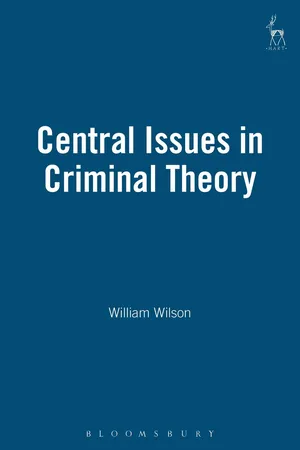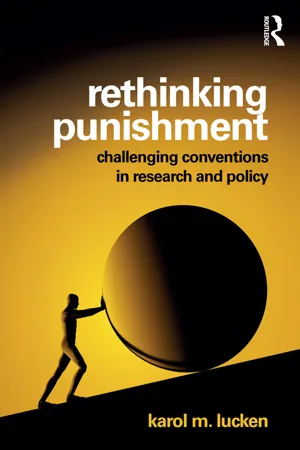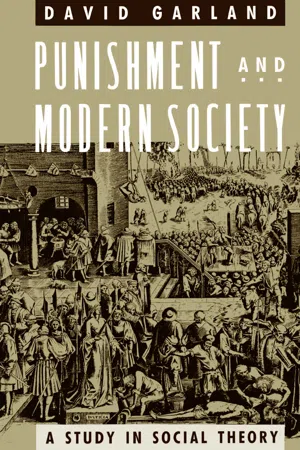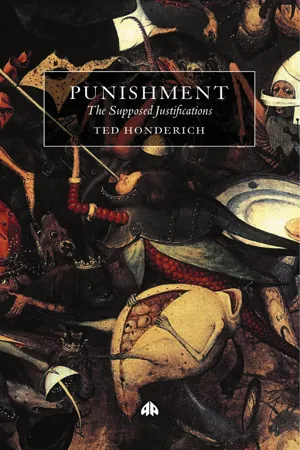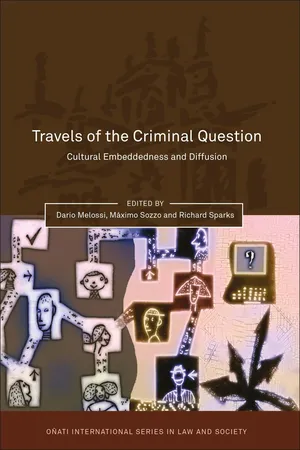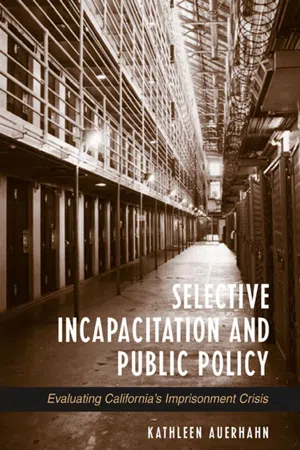Social Sciences
Criminal Punishment
Criminal punishment refers to the legal sanctions imposed on individuals who have been found guilty of committing a crime. It serves as a form of retribution, deterrence, rehabilitation, and societal protection. Punishments can include fines, community service, probation, imprisonment, or in some cases, the death penalty, and are intended to uphold social order and justice.
Written by Perlego with AI-assistance
Related key terms
1 of 5
11 Key excerpts on "Criminal Punishment"
- eBook - PDF
- Joel Samaha(Author)
- 2016(Publication Date)
- Cengage Learning EMEA(Publisher)
• Social justice. Prisons should be instruments of justice, and as such their collective effort should be to promote and not undermine society’s aspirations for a fair dis- tribution of rights, resources, and opportunities. (8) Now, we’re ready to turn our full attention to the Criminal Punishment imagination. Defining “Criminal Punishment” In everyday life, punishment means intentionally inflicting pain or other unpleasant consequences on another person. It takes many forms. A parent grounds a teenager; LO5 punishment intention- ally inflicting pain or other unpleasant con- sequences on another person Copyright 2017 Cengage Learning. All Rights Reserved. May not be copied, scanned, or duplicated, in whole or in part. Due to electronic rights, some third party content may be suppressed from the eBook and/or eChapter(s). Editorial review has deemed that any suppressed content does not materially affect the overall learning experience. Cengage Learning reserves the right to remove additional content at any time if subsequent rights restrictions require it. 22 CHAPTER 1 • CRIMINAL LAW AND PUNISHMENT IN U.S. SOCIETY a club expels a member; a church excommunicates a parishioner; a friend rejects a companion; a school expels a student for cheating—all these are punishments in the sense that they intentionally inflict pain or other unpleasant consequences (“hard treat- ment”) on the recipient. However, none of these is Criminal Punishment. To qualify as Criminal Punishment, penalties have to meet four criteria: 1. They have to inflict pain or other unpleasant consequences. 2. They have to prescribe a punishment in the same law that defines the crime. 3. They have to be administered intentionally. 4. The state has to administer them. The last three criteria don’t need explanation; the first does. “Pain or other unpleas- ant consequences” is broad and vague. - eBook - PDF
- William Wilson(Author)
- 2002(Publication Date)
- Hart Publishing(Publisher)
2 Punishing Wrongdoing C ENTRAL TO AN understanding of the criminal justice system is the phenomenon of punishment. It is through an understanding of the rationale of punishment that we can arrive at a cogent basis for evalu-ating both contemporary penal practices and the content of the crim-inal law. Theorists of punishment tend to espouse one of two basic approaches. The reductionist approach sees punishment as an instru-ment of social control designed to reduce antisocial activity, typically through isolation and deterrence, less typically through rehabilitation and education. The retributivist approach sees punishment as a morally appropriate and/or necessary response to wrongdoing by which, just as reward is the just response to good deeds, punishment is the just response to wrongdoing. It will be appreciated that depending upon which side of this punishment divide one inhabits so also will depend one’s attitude towards, for example, the form punishment should take, the gravity of punishment and the relevance of past misconduct. It will also influence one’s attitude to substantive issues. For example, from the reductionist point of view there is no inherent reason why criminal liability should be premised upon proof of moral fault. If it could be shown that deaths per thousand of population would be reduced by rendering criminal homicide an offence of absolute liability, an out and out reductionist will find it difficult not to support it. On the other hand, a retributivist could only sanction lia-bility where the killer was found to be morally deserving because he understood his conduct to create a risk of causing death or, in other accounts, because he was culpable in his failure to do so. WHAT IS PUNISHMENT ? Punishment is usually characterised as the essential distinguishing feature of criminal norms. Distinguishing criminal norms from other parts of society’s coercive apparatus is not just an interesting analytical exercise. - eBook - ePub
Rethinking Punishment
Challenging Conventions in Research and Policy
- Karol Lucken(Author)
- 2017(Publication Date)
- Routledge(Publisher)
The concept of punishment is relevant to a number of academic disciplines. As a result, countless definitions or conceptions of punishment have appeared in the philosophical, sociological, and criminological literature. Some definitions are rooted in specific theoretical traditions, while others are more casual in their composition. A sample of seven definitions is reviewed here. The sample represents four decades of thought, various academic fields and perspectives, and a diverse set of potential attributes for defining punishment.In the tradition of social learning theory, Burgess and Akers (1966) define punishment as the “imposition of unpleasant stimuli to decrease the frequency of certain behavior or the removal of desirable stimuli for the same reason.” In this definition, the justification (i.e., what purpose) for the act in question is generically expressed as decreasing the frequency of certain behavior. In other words, the definition does not turn on a philosophical motive. However, because the agent imposing or removing the stimuli is not identified (i.e., by whom), activity that is contrary to social punishment is included in the definition. For example, technically, self-inflicted stimuli and other practices occurring within the private confines of family, church, and work are included. This renders the definition unsuitable for distinguishing activity by the state.Working in the tradition of differential association theory, Sutherland and Cressey (1974: 298) define punishment as thatwhich is inflicted by the group in its corporate capacity upon one who is regarded as a member of the same group … that involves pain or suffering produced by design and justified by some value that the suffering is presumed to have.Unlike the Burgess and Akers’ definition, this definition distinguishes the agent and recipient of punishment as different parties. Consequently, acts that are self-inflicted are excluded. Sutherland and Cressey add another layer of distinction to the definition by incorporating a reference to a “same group.” They insert this reference to avoid the possibility of acts of war being included. - eBook - PDF
- Dunia Zongwe, Prince Zongwe(Authors)
- 2022(Publication Date)
- Langaa RPCIG(Publisher)
37 Chapter 4 Theories of punishment The preceding chapter demonstrated that the criminal character of conduct partly depends on the presence or absence of state-enforced punishment. As Husak observed, the most effective way to identify the nature of criminal law consists in checking whether a law or rule subjects a person to punishment by the state. 1 This insight connects theories of punishment to the theories of criminalization. In similar vein, this insight implies that answering questions about why society punishes certain conduct can help people resolve questions about why they have condemned or criminalized it. 1 Introduction This chapter introduces you to the theories of punishment. Those theories, also known as penal theories, dictate what happens to wrongdoers, considering their capacity to be changed or to do further damage. 2 This topic is fundamental to criminal law as it is generally regarded as the philosophical underpinnings of much of that field of law. The High Court of Namibia declared in van Den Berg that the role of the courts is to administer and achieve substantial justice, and that they can only fulfill this role when the real perpetrators of crimes are punished whilst innocent persons escape punishment for the wrongs committed by others. 3 Attempts at justifying how society reacts to criminal behavior are known as theories of punishment. The notion of ‘punishment’ contains at least six elements. Punishment entails (1) something unwelcome, (2) inflicted intentionally, (3) and for a reason provided, (4) by a person with authority to do so, (5) for conduct (i.e., act or 1 Douglas Husak, ‘Criminal Law Theory’ in Martin P Golding and William A Edmundson (eds), The Blackwell Guide to the Philosophy of Law and Legal Theory (Wiley-Blackwell 2004) 110. 2 Harry R Dammer and Jay S Albanese, Comparative Criminal Justice Systems (4th edn, Wadsworth, Cengage Learning 2011) 177. 3 S v van Den Berg 1995 NR 23 (HC). - eBook - ePub
Punishment and Modern Society
A Study in Social Theory
- David Garland(Author)
- 2012(Publication Date)
- University of Chicago Press(Publisher)
11 But if, as I suspect, this image is an impoverished one, and fails to capture the full dimensions and complexities of punishment, then the solutions offered by philosophy are unlikely to match up to the problems of the institution. What is needed now is really a preliminary to philosophy—a descriptive prolegomenon which sets out the social foundations of punishment, its characteristic modern forms, and its social significance. Only on this basis can philosophies be developed which adequately address the normative problems of this complex institution. Quite simply, we need to know what punishment is in order to think what it can and should be.2. THE SOCIOLOGY OF PUNISHMENT
The present study is thus conceived as a work in the sociology of punishment or, more precisely, in the sociology of criminal law, criminal justice, and penal sanctioning.12 Moving from the premiss that penal phenomena in modern society are problematic and badly understood, it seeks to explore the penal realm in all its different aspects, reopening basic questions about punishment’s social foundations, seeking to chart its functions and its effects. Its ultimate aim is to uncover the structures of social action and the webs of cultural meaning within which modern punishment actually operates, thereby providing a proper descriptive basis for normative judgments about penal policy.I take the sociology of punishment, broadly conceived, to be that body of thought which explores the relations between punishment and society, its purpose being to understand punishment as a social phenomenon and thus trace its role in social life. Being concerned with punishment and penal institutions, it shares its central subject-matter with ‘penology’, but is distinguishable from the latter by virtue of its wider parameters of study. Whereas penology situates itself within penal institutions and seeks to attain a knowledge of their internal ‘penological’ functioning (thoughout the nineteenth century ‘penology’ was a synonym for ‘penitentiary science’), the sociology of punishment views the institutions from the outside, as it were, and seeks to understand their role as one distinctive set of social processes situated within a wider social network. - eBook - ePub
Criminal Justice Theory
An Introduction
- Roger Hopkins Burke(Author)
- 2013(Publication Date)
- Routledge(Publisher)
6 Punishment in Modern SocietyThis chapter discusses the philosophy and theory of punishment in modern societies and locates this debate in the context of the four models of criminal justice development that provide the theoretical underpinnings of this text. It is important to remember that all too often punishment is considered to be a distinct and separate entity from the understanding of penology but it is impossible to legitimately understand one without the other, for imprisonment is, next to capital punishment, the harshest and certainly one of the most commonly used sentences. Without the acknowledgement of penal realities, justifications for punishment become mere intellectual debate. Trying to make sense of familiar concepts such as ‘making the punishment fit the crime’, is not strictly a theoretical question and these are not just philosophical matters of concern to academia. These questions have great practical relevance within the criminal justice process generally and the penal system specifically. By bringing the two together, locating penal trends in theory, and grounding theory in policy, the totality becomes greater than the sum of its parts.According to an old Muslim legend, there was once a rich king who left his servant in charge of his kingdom and in receipt of his riches, while he went on a long journey. Upon returning to his kingdom he found to his dismay that his servant had stolen some of his treasures. The rich king took the servant in front of the judge for sentencing. The judge ordered that both the servant and the king should be punished; the servant because he had broken the law, and the king because, by leaving such a great temptation in the hands of a person with so few possessions and possibly weak character (both realities which the king should have been able to assess), the king was in fact causing the man harm (Ellis and Ellis, 1989). - eBook - PDF
Punishment
The Supposed Justifications Revisited
- Ted Honderich(Author)
- 2005(Publication Date)
- Pluto Press(Publisher)
Our definition, so interpreted, is reasonably satisfactory for our purposes. Perhaps it does not fit everything that is ordinarily called punishment, whether by parents, teachers or irregular tribunals. Problem and Definition 15 It does fit the subject in hand. That is a dominant practice of control, or the dominant practice of control, within our societies. The offences, of which more will be said in due course (p. 214), include crimes involving the property of others, such as theft and damage, crimes of violence to persons, such as murder and assault, crimes consisting of certain acts considered to be immoral, and cer-tain crimes against the state and some of its institutions, including treason and the subversion of justice. The penalties are those fixed by law. In the main, the law sets down maximum penalties for offences. The choice in a particular case, fine or imprisonment or worse, is made by the judge or judges. If the given definition is suitable for our purposes, it is also true that it departs somewhat from definitions provided by philosophers who have considered the question of punishment in the past. This is so for several reasons, one of them that many philosophers have attempted to capture the most common or ordinary notion. Many people do have the feeling, maybe have been got to have the feeling, that at least part of the justification of punishment is that it is deserved, and this attitude finds expression in their use of the term. Some such implication is thus present in many definitions, as it was in our earlier definition. Also, of course, given this genesis of defini-tions in ordinary life, and a want of awareness there of the existence of strict and vicarious liability, the definitions have excluded a part of their intended subject matter. This has issued, if not in clear mistakes, at least in an overlooking of things of relevance. - eBook - PDF
Travels of the Criminal Question
Cultural Embeddedness and Diffusion
- Dario Melossi, Máximo Sozzo, Richard Sparks, Dario Melossi, Máximo Sozzo, Richard Sparks(Authors)
- 2011(Publication Date)
- Hart Publishing(Publisher)
2 Concepts of Culture in the Sociology of Punishment DAVID GARLAND, NYU* INTRODUCTION C ontemporary work in the sociology of punishment gives a prominent place to the concept of culture and to cultural analysis (Garland 1991; Savelsberg 1999; Smith et al 2000; Tonry 2001; Strange 2001; Lynch 2002; Vaughan 2002; Smith 2003a; Penfold 2004; Valier 2004; Crawley 2004; Gray and Salole 2005; Piacentini 2004, 2005). Indeed, it has become conventional wisdom that penal institutions have important cultural dimensions and consequences (Sarat 1999, 2001; Garland 2002; Sarat and Boulanger 2005) and that ‘cultural factors’ are prominent in the causal determinants that shape penal policies and practices (Melossi 2001; Simon 2001; Vaughan 2002a; Whitman 2003; Zimring 2003). A parallel emphasis on ‘the cultural’ is also apparent in contemporary criminology (Ferrell 1999; Presdee 2000; Hayward and Young 2004; Ferrell et al 2004). In these respects, the sociology of crime and punishment is aligning itself with an intellectual trend that has occurred all across the humanities and social sciences – a cultural turn (Bonnell and Hunt 1999) that seems altogether appropriate in our mass-mediated, image-saturated, late-modern world. But this embrace of ‘culture’, however timely and appropriate, threatens to introduce a degree of conceptual confusion into the field, not least because the notion of ‘culture’ is notoriously multivalent, both as a theoretical concept * This paper began as a presentation to a conference on ‘Discourses and Practices of Crime and Punishment: The Question of Cultural Embeddedness and Travels’, organised by Dario Melossi, Máximo Sozzo and Richard Sparks in Onati, Spain in 2003. The author is grateful to the conference organisers and participants and also to Lynn Chancer and two anonymous referees for their comments and criticisms. An earlier version appeared in 10 Theoretical Criminology (2006) 4, 419–47. - eBook - PDF
Selective Incapacitation and Public Policy
Evaluating California's Imprisonment Crisis
- Kathleen Auerhahn(Author)
- 2012(Publication Date)
- SUNY Press(Publisher)
What follows is a brief historical sketch of the evolution of penal purpose in Western society. Although my ultimate concern is with penal ideology in the United States, we must first look to developments in England and Europe to understand the origins of American criminal justice. This account focuses pri- marily on the ideologies surrounding the use of the prison; however, the prison’s place in the enterprise of Criminal Punishment cannot be fully understood without reference to the penal practices that preceded it. HISTORICAL ANTECEDENTS OF THE PRISON The Ancient Period The earliest recorded statements on the place of Criminal Punishment in society indicate that utilitarian considerations were foremost in justifying the punish- ment of offenders in ancient societies. J. Thorsten Sellin’s (1976) historical analysis of Criminal Punishment shows that for the ancients, the purpose of in- flicting punishment was unequivocally forward-looking, rooted in the objectives of deterrence and rehabilitation. Sellin offers this excerpt from the writings of the philosopher Protagoras (481–411 B.C.E.): He who desires to inflict rational punishment does not retaliate for a past wrong which cannot be undone; he has regard for the future and is desirous that the man who is punished, and he who sees him pun- ished may be deterred from doing wrong again. He punishes for the sake of prevention, thereby clearly implying that virtue is capable of being taught. (in Sellin 1976:13) Socrates (470–399 B.C.E.) offers a similar view: “the object of all punishment which is rightly inflicted should be either to improve and benefit its subject or Criminal Punishment in Civil Society 19 else to make him an example to others, who will be deterred by the sight of his suffering and reform their own conduct” (in Sellin 1976:13). The criminal laws of ancient Rome reflect this deterrent emphasis as well. - eBook - PDF
- Lee V. Hamilton, Joseph Sanders(Authors)
- 1991(Publication Date)
- Yale University Press(Publisher)
7 Offenses in a family are normal expected oc-currences. Punishment is not something a child receives in isolation from the rest of his relationship to the family; nor is it some-thing which presupposes or carries with it a change of status from child to criminal child/' When a parent punishes his child, both parent and child know that afterward they will go on living together as before. The child gets his punishment, as a matter of course, within a continuum of love ... and he is punished in his own unchanged capac-ity as a child with failings (like other chil-dren) rather than as some kind of distinct and dangerous outsider. (Griffiths, 1970, p. 376) In the last chapter we focused on the attribution of responsibility. We turn now to the question of sanctions. 1 Sanctions routinely presuppose responsibility (Hart & Honoré, 1959), and many of the hypotheses we have raised with respect to responsibility also apply to sanctioning. As the epigraph indicates, wrongdoing that may be the occasion for punishment has community attributes as well as individual attributes. For example, harm may be perpetrated against a stranger or an acquaintance (a community attribute) as well as perpetrated unintentionally or intentionally (an individual attribute). Correspondingly, sanctions for wrongdoing have consequences for communities as well as for individuals. Thus, like responsibility decisions, everyday sanctioning decisions may be influenced by the actor's deed and the context within which the act occurred, as well as by the relationship of the parties in dispute. The microsociology of punishment, like the microsociology of responsibility, needs to take account of people's roles and social ties as well as their deeds. Furthermore, at the macrolevel, we have suggested that the legal culture and its conceptions of the responsible actor may vary in different societies as a function of the 135 Punishment - eBook - ePub
Foucault - The Key Ideas
Foucault on philosophy, power, and the sociology of knowledge: a concise introduction
- Paul Oliver(Author)
- 2010(Publication Date)
- Teach Yourself(Publisher)
The use of extreme forms of punishment during the eighteenth century and earlier ultimately received its justification from the sovereign of the state concerned. When a crime was committed, it was essentially not against society, but against the sovereign. The profound nature of such an act led to the justification of a broad range of unpleasant physical punishments. Although the punishment was considered as a public event to be watched and perhaps even enjoyed by the masses, there was also during the eighteenth century a developing opposition to such punishment. Living conditions for the majority of people were so adverse that there was a sense that state officials and ultimately the sovereign were self-serving rather than fulfilling responsibilities towards the populace. Hence when ordinary working-class people were ill-treated or executed for minor offences – often simply theft of food to assuage hunger – there was an evolving feeling of unfairness, leading ultimately to the seeds of social and political revolt. These kinds of feelings gave great support to those who considered it necessary to reform the system of punishment.InsightFoucault noted that public execution involving torture provided the kind of public spectacle to which the general populace rarely had access. On the other hand, he also observed that there was often a degree of public sympathy for the offender: the crowd would often shout offensive remarks directed at the government or others in authority for inflicting such a cruel punishment.Towards the end of the eighteenth century, Foucault argued, the structure and nature of society began to change. Notably, society was becoming far more organized and regulated. In general, as we have already seen, citizens were subject to closer observation by administrative and quasi-governmental authorities. Incipient police forces were developed with the purpose of monitoring the citizenry, and placing in confinement anyone who might have transgressed. The greater organization of society led to a system of rules and regulation that permitted the citizen to know when they had transgressed, and the judiciary to assess accurately and objectively, the appropriate punishment.There was also a changing sense of morality in society. Offences were seen rather less as crimes against government, authority or those in power, but rather more against the nature of society itself. A criminal offence was a crime against other citizens, against one’s neighbours or community. Crime was a social offence and it was necessary for the punishment to be viewed as appropriate to the offence. There thus developed a social morality where different types of crime were viewed as more unethical than others.InsightTowards the end of the eighteenth century crimes began to be evaluated in terms of the extent of their negative effects on society, and the extent to which they reduced the cohesion of society. For instance, one element of such social cohesion was that people should work hard and gain from the proceeds of that hard work. Theft was seen to be serious because it undermined the advantages of hard work.
Index pages curate the most relevant extracts from our library of academic textbooks. They’ve been created using an in-house natural language model (NLM), each adding context and meaning to key research topics.

